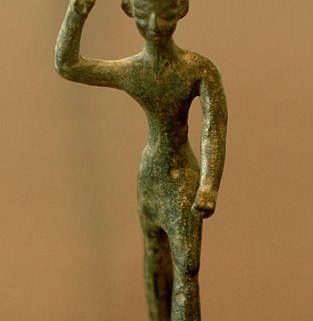Before God revealed the true nature of the afterlife to us through Jesus and, to a lesser degree, the prophets and apostles, the ancient world had a very different idea about what came after death. The people who dominated the world during the time of the patriarchs, the Amorites, believed that the quality of life after death depended on one’s children, and their children, and their children, et cetera, until the end of time. There was more to it than that. The people of the Near East in Abraham’s day never really said goodbye to their ancestors. The dead hung around, always near, as part of everyday life. In fact, they required the attention of their descendants, and through the rituals of the living, those who’d passed on remained an active part of family, tribe, and community. Life among the Amorites of the second millennium BC, at least as far as one’s relationships with family and tribe, both living and dead, were very similar to the ancestor veneration found today in many parts of the world. It may seem odd to Protestants, but the practice is widespread and very old. The earliest written accounts that describe and explain the practice come from the Amorites of the ancient Near East. Mesopotamians four thousand years ago believed the netherworld was a dark, dreary place. The only food and drink available to the dead was what was provided by one’s descendants. The living were bound by duty to summon the ancestors to a ritual meal called the kispum on the thirtieth day of each month. This was the night of no moon, the darkest night, when the veil between the world of the living and the land of the dead was apparently thinnest. This is likely why one text in Sumerian and Akkadian from the time of Abraham described the last day of the month as “the evil day,” “dangerous day,” “the day of the kispum,” “day of the disappearance,” and “the day of ‘purification’.” This wasn’t like children putting out cookies and milk for Santa Claus on Christmas Eve. The kispum was a necromancy ritual at which the family called the ancestors by name. Failure to perform the rite condemned the ancestors to a gloomy existence of dull, constant hunger. The monthly kispum rite may have originated with the Amorites. The first written references to it date from the early second millennium BC, which is when control of Mesopotamia shifted from the Akkadians and Sumerians to the Amorites. The ritual was comprised of three elements: a communal meal, šuma zakāru (“remembering the name”), and mē naqû (“pouring the water”). Dead ancestors were represented by statues call en-en-ku-ku (“lords who are sleeping”). These statues are probably what the Bible calls teraphim, the household gods stolen by Rachel when Jacob fled from his father-in-law Laban (see Genesis 31). The food provided to the dead was simple—bread, cold water, hot broth, flour, honey, and maybe some wine or beer flavored with roasted grain. Liquids might be poured into a pipe inserted into the earth, presumably to deliver it directly to the deceased. The provision of water was so important that the family heir who was responsible for the monthly kispum was called a “pourer of water.” It’s hard for us in the modern world to grasp how crucial these monthly rites were in ancient Mesopotamia. Participation in the afterlife absolutely depended on one’s descendants faithfully fulfilling their duties every New Moon. This not only nourished the dead through the long years in the netherworld; it kept them pacified. This was important—the dead were dangerous! To guarantee that the heir, usually the eldest son, did right by the expired ancestors, inheritance was tied to the performance of the kispum. Receiving one’s birthright was conditional on performing the monthly rites. Disobedient children might be punished in a will by being barred from accessing the gods and the dead of the recently deceased. The month of Abu in the Babylonian calendar (the Hebrew month of Ab, or July/August) seems to have been especially important in the annual cycle of the kispum. A letter from Ammi-ditana, the Amorite king of Babylon during the seventeenth century BC, a contemporary of Jacob and Joseph, calls for milk and butter for the offerings that month. It seems that Abu was believed to be a good time to ask dead relatives to leave the living in peace and to consult them for supernatural advice about how to cope in the world of the living. Interestingly, the name of the month may derive from a Semitic term ab, meaning “entrance to the netherworld.” In Hebrew, ab means “father,” but in the broader sense of honored ancestors or deities. Many of the gods worshiped in Mesopotamia were called “father,” such as the creator-god of Canaan, El, the “father of mankind,” and the war-god Chemosh, who is described as the father of the Moabites in Numbers 21:29. This has relevance beyond trying to understand the ancient Mesopotamian monthly meal for the dead, because another word based on ab, the Hebrew abarim (“travelers”), identifies the mountain from which Moses got his only look at the Promised Land and the battleground where the army of the Antichrist will fall. Ab is also a component of the name “Moab,” where the Israelites camped before crossing the Jordan (and the site of the “mountain of the Abarim,” Mount Nebo). The most common explanation of the etymology of Moab (“from father”) derives from the Bible’s origin story of the nation; the patriarch of the Moabites was a child of incestuous unions between Abraham’s nephew Lot and his daughters, who plied their father with wine when they despaired of having children after losing their fiancés in the destruction of Sodom and Gomorrah. Likewise, Moab’s northern neighbor, Ammon, was founded by Lot’s other son/grandson, Ben-Ammi, whose name means “son of my people.” The relationships between the living and the dearly departed were so important that scholars haven’t found any communal cemeteries among Amorite settlements from the Old Testament period—in other words, when the Amorites controlled the lands of the Bible. Families buried their dead under the floors of their homes, maybe so the dead only had to travel about six feet, more or less, to attend the kispum. This practice is even mentioned in the Bible. Have you ever wondered why the prophet Samuel was buried “in his house at Ramah”? That wasn’t a figure of speech; it was the custom of the time and culture in which Samuel, Saul, David, and Solomon lived. This dedication of the living to the dead, and the dependence of the dead on the living for their existence after death, is likewise reflected in the story of Abraham. I’ll explain how in next month’s article.

Derek Gilbert Bio
Derek P. Gilbert hosts SkyWatchTV, a Christian television program that airs on several national networks, the long-running interview podcast A View from the Bunker, and co-hosts SciFriday, a weekly television program that analyzes science news with his wife, author Sharon K. Gilbert.
Before joining SkyWatchTV in 2015, his secular broadcasting career spanned more than 25 years with stops at radio stations in Philadelphia, Saint Louis, Little Rock, and suburban Chicago.
Derek is a Christian, a husband and a father. He’s been a regular speaker at Bible prophecy conferences in recent years. Derek’s most recent book is The Great Inception: Satan’s PSYOPs from Eden to Armageddon. He has also published the novels The God Conspiracy and Iron Dragons, and he’s a contributing author to the nonfiction anthologies God’s Ghostbusters, Blood on the Altar, I Predict: What 12 Global Experts Believe You Will See by 2025, and When Once We Were a Nation.





Leave a Reply
Want to join the discussion?Feel free to contribute!